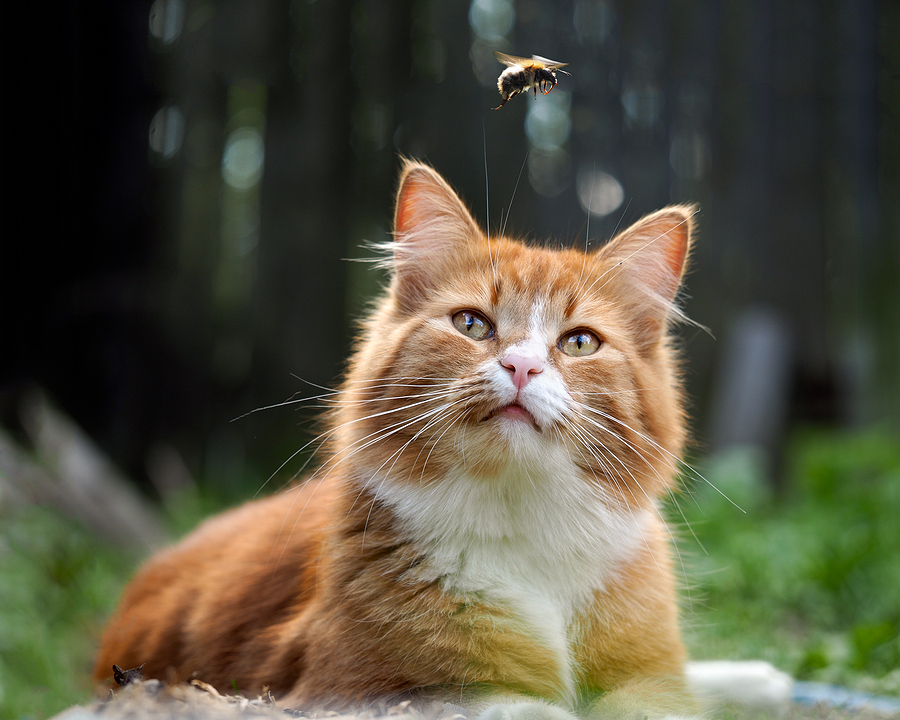Cats love to play and bugs are often tempting prey. If your cat is playful and curious, he might stick his paw too close to a bee or wasp and get stung. In most cases, cats will heal from a bee sting on their own and will need only minor first aid. However, some cats have life-threatening allergic reactions to being stung. Monitor your cat for signs of allergic reactions and consider contacting a vet.
Should your kitty cat get stung by a bee, here are some tips on how to handle this nerve-wracking situation.
Act fast
A bee can only sting once, but the stinger will be left in your cat’s skin. It might continue to pump venom for several minutes, so act fast by removing the stinger quickly to reduce pain and swelling.
Look for signs of a bee sting
Cats tend to hide their pain and it might not be obvious that a bee sting has occurred. Cats are usually stung around their face and paws. They might limp or paw and scratch at the sting. Look for a small, swollen bump where the sting took place.
First Aid

As soon as you realize your cat has been stung, remove him from the area and find a safe space to evaluate and treat your cat. Although one sting is unlikely to cause a severe reaction, other bees or wasps might be nearby. Most serious insect bite reactions come from being stung multiple times.
If your cat gets stung by a bee, it is important to remove the stinger quickly. Scrape the stinger out using the edge of a driver’s license or credit card. Don’t pinch the stinger out with tweezers, as it might crush the venom sack, worsening the sting.
After the stinger is removed, evaluate your cat’s injuries. Search your cat’s fur to make sure there are no other insect stings. Monitor your cat’s symptoms to watch for a more severe allergic reaction. Most insect stings don’t require veterinary care.
When to visit the Vet

Consider visiting a vet immediately if your cat has been stung several times or if the insect sting occurred inside of the mouth. It’s likely worth a call to your vet regardless of where or how many times your cat was stung.
If your cat is only experiencing minor swelling, a cold compress will help reduce symptoms. Frozen vegetables, an ice pack, or a cold towel applied to the site will help reduce swelling and soothe the pain.
Diphenhydramine/Benadryl can reduce swelling and minimize allergic reactions in cats, but you should always be cautious in giving your cat over-the-counter medicines. Read the label carefully to make sure there are no pain medications mixed in with your medicine. Many pain medicines are toxic to cats. Dosage also varies from cat to cat. PetMD recommends you give your cat 1 mg of Benadryl per pound of your cat’s weight in the case of insect bites. If you have any concerns about giving your cat over-the-counter medicines, contact your vet for specific advice or skip the medicine.
Most of the time, bee stings only result in minor swelling and discomfort for your cat. In rare cases, a sting can lead to an extreme reaction called anaphylactic shock.
Early warning signs include:
- Diarrhea or abnormal defecation/urination
- Swollen muzzle or tongue
- Vomiting
- Itchiness
- Hives
Later symptoms include:
- Behavioral changes
- Weakness or lethargy
- Weak pulse or elevated heart rate
- Cold limbs
- Drooling
- Difficulty breathing
- Pale gums
- Collapse
If your cat experiences symptoms of anaphylactic shock, contact your vet immediately. Anaphylactic shock is often fatal if it is not treated promptly.
Although some insect stings can be serious, most cats will heal rapidly following a bee sting. Administering basic first aid can help your cat be more comfortable after being stung. Don’t panic after a bee sting, but do treat the sting seriously. Knowing the signs of a serious reaction may save your cat’s life.



